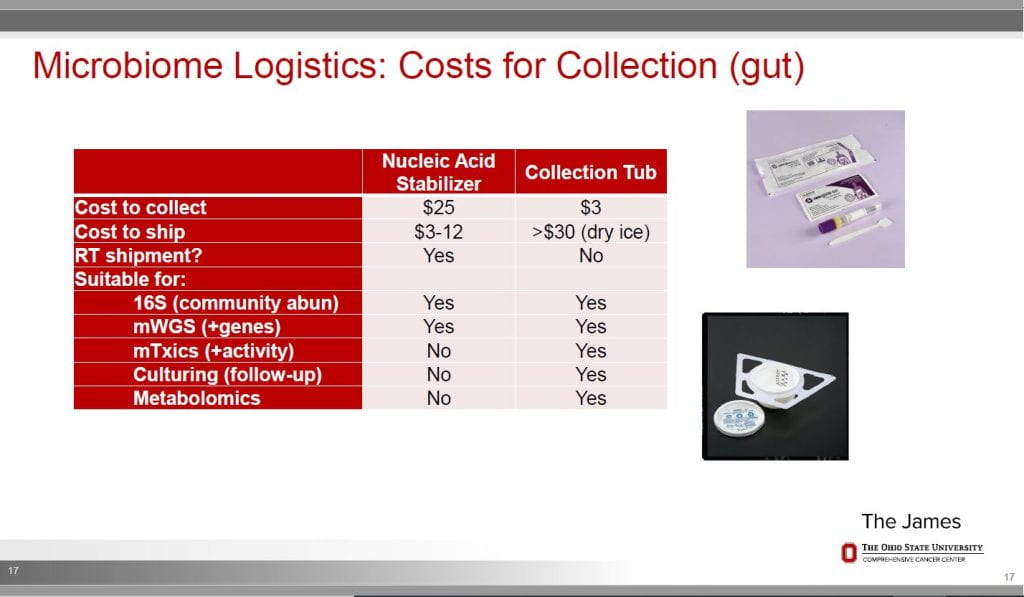Full video presentation (approx. 32 minutes)

The purpose of the Center of Microbiome Science is to galvanize and organize the community around the broad types of microbiome science going on around OSU across the different colleges and faculty members and to find some way that we can all work together. It turns out that many of the logistics for actually getting started are specific to your college, and that includes the details of how to collect samples. There’s a lot of overlap with how to generate data from those samples, as well as how to analyze them, but the initial part—the process for collecting samples—is unique to the College of Medicine. Given the number of requests for information that we’ve received, I put together some basic information to get you started.
The main focus is around the logistics. You’re in the College of Medicine. These are my recommendations for how you can collect microbiome samples, where you might generate the data, how to do it internally, if you so desire, and how to analyze it. Then, I want to let you know where to find additional help. I could have said, for all of these things, just talk to us. But the goal is for you to learn how to do this type of research without talking to us at all if you don’t want to.
Examples of How the Microbiome Can Be Used in Practice and Research:
- As a Biomarker: There’s been a lot of use of the microbiome as a biomarker for pretty much any disease state that you can think of. There have been groups that have looked at people who have a disease and people who don’t; they look at the microbiome in both populations and ask whether or not there are differences. In one particular area, I find it extremely exciting: in response to immune checkpoint inhibitors (ICIs). Before a person starts treatment, you can take a little bit of their stool. With some error, you can predict whether or not that person is going to be a responder.
- As a Therapeutic Target: You can take people who are treatment resistant—they had been on ICIs and became resistant and progressed on them. They were then given a fecal transplant—stool is taken from a person who responded to ICIs and transferred to the person who did not or who had progressed. In some cases, the original person started responding to the same treatment again, just after a fecal transplant; that’s all that was changed.
- Amenable to Mechanistic Studies: Stool from patients can be gavaged into preclinical models, which often recapitulate several phenotypes observed in the patient, such as response to ICI treatment. Individual microbes can be gavaged or supplemented into a complex stool gavage to determine the effect of composition changes.
- Can Be Useful Additional Aim in a Grant Application: Using the microbiome is another way of adding innovation to a research proposal and of exploring ways to address some of the potential results observed.
What Is the Process?
If you are interested in collecting microbiome samples, how do you do it within the College of Medicine and what are the first steps? Here is a basic workflow that could get you from a grant application to the analysis, without having to talk to any particular person. Of course, you can always reach out to me or the Center of Microbiome Science with questions before you get started.

Step 1: Sample Collection
The kit that’s shown in the picture (right) is a very reasonable way to start. It’s suitable for some, but not all, types of analysis. You can store these in the clinic & they can be handed out or mailed to patients. Typically, once someone has consented to a trial, we give them the kit, which they bring home to collect their sample and mail it directly to the processing center. Each kit costs around $25. (Kits available through the OSUCCC Biospecimen Shared Resource)


Step 2: Sequencing
There are two places we recommend for generating the sequencing data:
- Applied Microbiology Services Laboratory (AMSL)
- IGM Genomic Service Laboratory (Nationwide Children’s Hospital)

Step 3: Analysis
The analysis of samples is where an interaction with the Center of Microbiome Science can be especially helpful. AMSL built out a Microbiome Platform to automate regular processing and analyses, with bespoke analysis available as a fee-for-service model. However, the Center of Microbiome Science has established and maintains cutting-edge tools on the Ohio SuperComputing Center clusters, available for access by collaborators or bioinformatics shared resource support staff. In addition, the Center of Microbiome Science supports weekly office hours where project-specific questions can be addressed.

Clinical Protocols
Please see this post for our preferred language and suggested appendices if you want to add microbiome collection to a clinical trial protocol.
Additional information
If you’d like a consultation through CoMS, please use the following link.
Stay tuned for a link to the CCTS concierge service.
Questions? Dan Spakowicz, PhD, MS